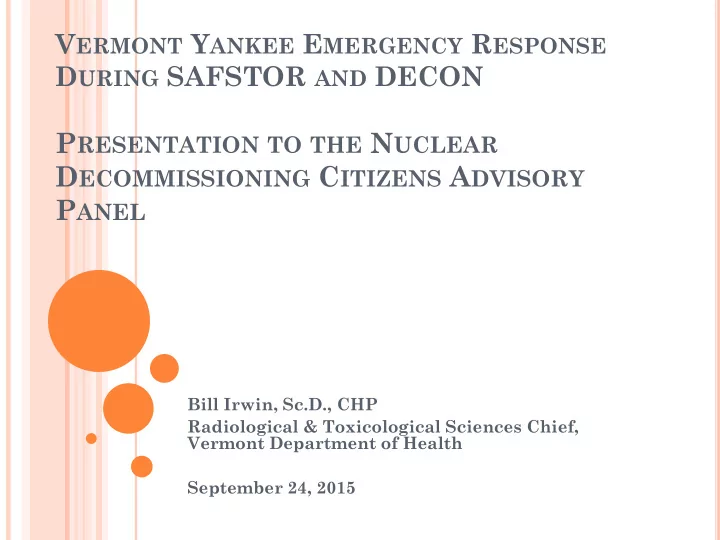

V ERMONT Y ANKEE E MERGENCY R ESPONSE D URING SAFSTOR AND DECON P RESENTATION TO THE N UCLEAR D ECOMMISSIONING C ITIZENS A DVISORY P ANEL Bill Irwin, Sc.D., CHP Radiological & Toxicological Sciences Chief, Vermont Department of Health September 24, 2015
C URRENT N EEDS & C APABILITIES A CCORDING TO E NTERGY AND THE NRC Through April 2016, the incidents that require offsite response capabilities are spent fuel accidents including those that result in overheating of the spent fuel within the spent fuel pool. Other incidents do not require an offsite response because the dose to the public from those accidents will be less than the Environmental Protection Agency (EPA) Protective Action Guidelines (PAGs).
R ESOURCES SUPPORTED BY E NTERGY T HROUGH A PRIL 2016 Those needed by the six Emergency Planning Zone town Emergency Operations Centers, the State Emergency Operations Center, and several state agencies for full-scale implementation of the current Radiological Emergency Response Plan (RERP). The capabilities that are supported include: Notifications and continuous communications Evacuation, shelter and reunification Radiological accident assessment Radiological environmental assessment Incident management Law enforcement, fire safety, emergency medical services Food and water protection, restrictions and replacement Recovery
N EEDS & C APABILITIES A FTER A PRIL 2016 A CCORDING TO E NTERGY AND THE NRC No accidents will result in doses in excess of the EPA Protective Action Guidelines (PAGs)*. As such, no offsite capabilities beyond what local fire, law enforcement and emergency medical services can provide require Entergy support. *The EPA PAGs are found at http://www.epa.gov/radiation/docs/er/pag-manual-interim- public-comment-4-2-2013.pdf .
T HE EPA P ROTECTIVE A CTION G UIDELINES According to the EPA, their guidance “does not address or impact site cleanups occurring under other statutory authorities such as the: United States Environmental Protection Agency’s (EPA) Superfund program, the Nuclear Regulatory Commission’s (NRC) decommissioning program, or other federal or state cleanup programs”.* Nonetheless, Entergy and the NRC use the guidance to address emergency planning during site cleanup occurring under the NRC decommissioning program. *EPA PAG Manual, page i.
T HE EPA P ROTECTIVE A CTION G UIDELINES The purpose of the EPA Protective Action Guidelines is to help public officials decide whether to evacuate, shelter-in-place, administer potassium iodide, provide alternate sources of water, interdict food or milk, and other actions.* These actions are designed to avoid public doses over specific thresholds. The EPA PAGs were not intended to determine whether facilities support offsite emergency response capabilities. *EPA PAG Manual page 1
T HE EPA P ROTECTIVE A CTION G UIDELINE D OSE From the EPA PAG Manual page 7
O FFSITE E MERGENCY R ESPONSE N EEDS & C APABILITIES A CCORDING TO THE V ERMONT D EPARTMENT OF H EALTH Needs are not based solely on dose. Doses below the EPA PAG dose thresholds are unacceptable from incidents occurring at a shutdown nuclear power station awaiting cleanup. What yields dose to members of the public is contamination that was released and deposited offsite. Offsite radioactive contamination of the environment has human impacts, especially psycho-social and economic impacts. Disregarding the possible added risk of cancer from excess radiation dose, socioeconomic effects can lead to adverse physiological health impacts.
V ERMONTERS W ILL D EMAND A R ESPONSE TO C ONTAMINATION OF T HEIR E NVIRONMENT AND R ISK TO T HEIR E CONOMIC W ELL - BEING This contamination has to be measured. Measurements are made of samples taken from the environment. Samples and measurements are obtained, calculated, interpreted by and acted upon by people with skills other than those possessed by firefighters, law enforcement officers and emergency medical service providers, the only offsite responders funded after June 30, 2016. The state has developed and time-tested exceptional capabilities for these functions. Each year that passes after the state ceases these tasks, the capacity to start them up in response to an incident weakens more.
O FFSITE E MERGENCY R ESPONSE N EEDS & C APABILITIES A CCORDING TO THE V ERMONT D EPARTMENT OF H EALTH We concede that most nuclear emergencies for which we have been prepared for decades during reactor operations are not going to occur, and the resources needed for response and recovery may be scaled back. We maintain that zero resources is not the appropriate amount to which the state and locals should scale back.
W HAT K INDS OF R ELEASES ARE P OSSIBLE ? Leaks or release of radioactive materials inside structures, systems and components left in SAFSTOR into the air or soil. Causes include: Transportation accidents; An air release due to the combustion of radioactive materials by fire; Loss of container integrity by the effects of natural phenomena like flooding or earthquakes; Hostile actions, including ground or air attack. Groundwater carriage of radioactive materials in soils on site from: Past leaks Stack fallout Surficial spills
W HAT W OULD W E R EALISTICALLY N EED We should continue to independently monitor environmental media around the station Helps us identify contaminants from the very large quantity of radioactive materials stored on site until the facility is decontaminated and dismantled and the NRC license is terminated. Projected for 2072 in the PSDAR. Keeps our sample collection and analysis skills which we would need should there be a release fortified through periodic training. Maintain the capacity to measure hard-to-detect radionuclides like strontium-90 and transuranics. Both were significant concerns at other decommissioning sites. The Department of Health can develop a scaled-back budget for what is appropriate during SAFSTOR and DECON.
T HANK YOU ! Q UESTIONS ? WILLIAM . IRWIN @ VERMONT . GOV
Recommend
More recommend